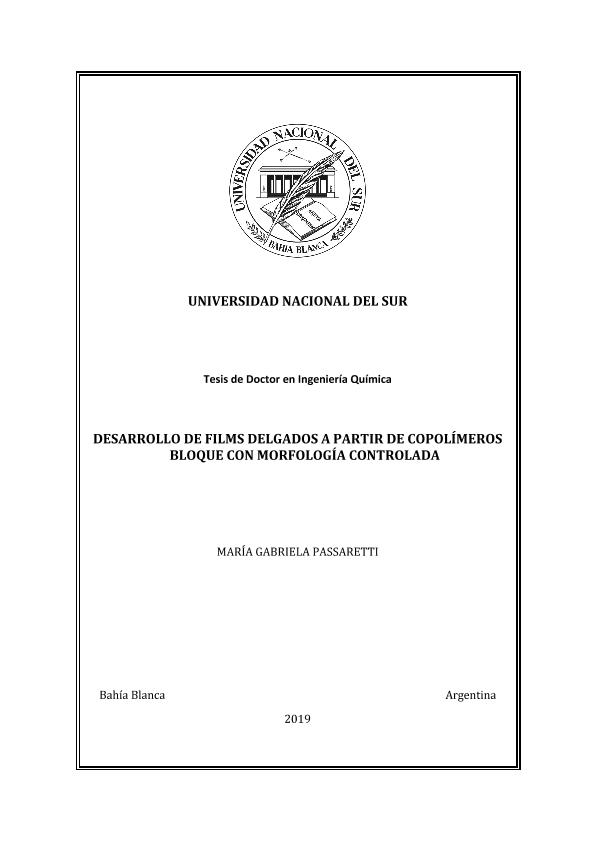Tesis doctoral
Un material compuesto es un material que se forma por la mezcla de dos o más materiales con propiedades diferentes entre sí, que al combinarse producen un nuevo material con propiedades distintas al de sus componentes individuales. En los materiales particulados, el componente mayoritario se conoce como matriz y el minoritario como relleno. El interés industrial por los materiales compuestos a base de matrices termoplásticas se debe principalmente a la versatilidad de usos y aplicaciones que presentan. Los rellenos (o cargas) de mayor interés comercial son los de origen mineral debido, principalmente, a su relativo bajo costo y alta disponibilidad, dando lugar al desarrollo de nuevos materiales compuestos de un costo relativamente bajo. Utilizando diferentes polímeros como matriz y distintos rellenos se pueden modificar las propiedades ópticas, térmicas, de barrera, mecánicas, etc., y, de esta forma, diseñar materiales compuestos “a medida” para distintas aplicaciones específicas. La correcta dispersión de las partículas de relleno depende en gran medida de la compatibilidad entre el polímero y la carga, y también de los métodos empleados para su obtención y procesamiento. Algunos de los métodos más utilizados son el mezclado en fundido, en solución o una combinación de ambos.
Por otro lado, durante las últimas décadas ha crecido el interés por el desarrollo de materiales poliméricos con fuerte anisotropía en sus propiedades eléctricas, magnéticas, mecánicas, ópticas, de transporte o térmicas para su uso en variadas aplicaciones, tales como sensores y actuadores, prótesis óseas, electrónica, fotónica y membranas, entre otros. Los copolímeros bloque resultan de particular interés debido a los diversos arreglos macroscópicos que presentan, permitiendo un control sobre la distribución y orientación de las cargas.
En esta tesis se desarrollaron películas de materiales compuestos a base de diferentes matrices poliméricas termoplásticas utilizando dos tecnologías de procesamiento. Para modificar las propiedades de las películas desarrolladas, se incorporaron diferente tipo de cargas. La aplicación posterior de flujos de corte y tratamientos térmicos mejoro aún más la estructura interna de largo alcance y las propiedades finales de los compuestos. Las películas obtenidas se caracterizaron mediante técnicas complementarias de análisis para estudiar la morfología y determinar las propiedades finales.
Los resultados obtenidos mostraron que los materiales desarrollados orientados se pueden proponer como membranas selectivas para remoción de nitrógeno de corrientes de gas natural y remoción de dióxido de carbono post combustión. En cuanto a las películas compuestas obtenidas por mezclado en fundido y termo-compresión, se comprobó su capacidad de barrera a la radiación UV, protegiendo aguas saborizadas susceptibles a este tipo de radiación. A composite material is a material obtained from combining two or more constituent material with different properties between them that, when combined produce a new material with different properties from the individual components. In the case of particulate composites, the component with higher concentration is known as the matrix while the one with lower concentration is the filler. The industrial interest for composite material based on thermoplastic matrices is mainly due to the versatility of the material, in relation to its uses and applications. The fillers (or charges) of high commercial interest are those of mineral origin, mainly owing to its relative low cost and high availability, resulting in the development of new relatively low cost composite materials. Using different polymer as matrix and different fillers, it is possible to modify the material (optical, thermal, barrier and mechanical, etc) properties and thus, design tailored composite materials for different specific applications. The correct dispersion of the filler particles largely depends in the compatibility between the polymer matrix and the filler particles, and also on the methods used to obtain and Process the composite material. Some of the most used methods are the melt mixing, solution mixing or a combination of both.
Moreover, the interest for developing polymeric materials with strong anisotropy on its (electric, magnetic, mechanical, optical, transport or thermal) properties has greatly increased in the last decades due to its potential use on various applications like: sensors, and actuators, bone prosthesis, membranes and other uses in the fields of electronics and photonics. Block copolymers are of particular interest due to the multiple macroscopic arrangements that they can feature, which allows controlling the distribution and orientation of the fillers.
In this thesis, composite material films were developed, using different thermoplastic polymeric matrices and two processing technologies. In order to modify the properties of the films, different kind of filler were introduced. The subsequent application of shear flows and thermal treatments further improved the long range internal structure and final properties of the composites. The films were characterized through complementary analysis techniques in order to study the morphology and determine its final properties.
The results showed that the developed oriented material can be proposed to be used as selective membranes for nitrogen removal from natural gas streams and carbon dioxide removal post-combustion. Regarding the composite films obtained from melt mixing and thermo compression, its UV radiation barrier capacity was proved, which was tested for the protection of flavored water sensitive to this type of radiation.
Desarrollo de films delgados a partir de copolímeros bloque con morfología controlada
Passaretti, María Gabriela

Director:
Villar, Marcelo Armando

Codirector:
Vega, Daniel Alberto

Fecha de publicación:
26/03/2019
Idioma:
Español
Resumen
Archivos asociados
Licencia
Identificadores
Colecciones
Tesis(PLAPIQUI)
Tesis de PLANTA PILOTO DE INGENIERIA QUIMICA (I)
Tesis de PLANTA PILOTO DE INGENIERIA QUIMICA (I)
Citación
Passaretti, María Gabriela; Villar, Marcelo Armando; Vega, Daniel Alberto; Desarrollo de films delgados a partir de copolímeros bloque con morfología controlada
; 26-3-2019
Compartir



